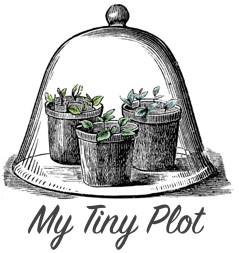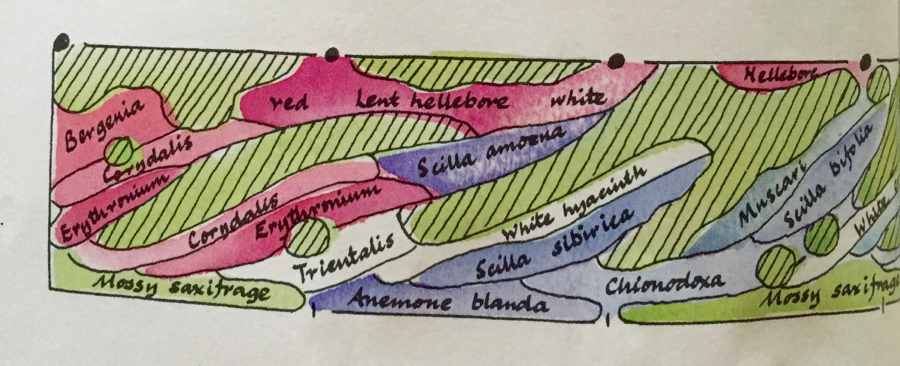A Spring Bulb Garden

I’ve been thinking a lot about colour since I recently bought Gertrude Jekyll’s book ‘Colour Schemes for the Flower Garden‘. It’s the first Jekyll book I’ve read but I really like her writing style. Sort of Monty Don meets Christopher Lloyd.
Anyway, she really likes the idea of separating gardens for either colour or seasonality. For example she created a Spring bulb garden that simply had hundreds of Spring bulbs in it like Anenome, Scilla, Hyacinth, Muscari and Narcissus mixed with early flowering plants like Helebores, Bergenia and Corydalis.
Then she had the problem that the garden wasn’t much to look at for the rest of the year and so she planted it out with drifts of ferns which were cut back in Winter. Then the bed was essentially bare when the bulbs came up and when the bulbs died back the Ferns gave Summer interest and hid the ugly dieback of the bulb leaves. Genius! And very practical.
Above: The left side of the Spring bulb plan from ‘Colour Schemes for the Flower Garden‘.
Above: The right side. As you can see the colours move from reds and blues to yellows. The green cross-hatching is where the Ferns are planted in drifts.
She also talks about the location of the Spring garden. It should be in a part of the garden that you use a lot during early Spring. I, for one, don’t really venture deep into the garden at this time of year. For example I hardly every walk over the other side of the lawn. Squelching mud stands in my way so I just avoid it. So… over there would be an unadvisable place for a Spring garden.
At this time of year I spend a lot of time looking out of my kitchen window or getting in and out of my car. Both would be great spots for a Spring Garden.
Of course we don’t all have 70 foot beds to give over to ‘just Spring bulbs’. But creating a small dedicated Spring bulb garden may be the key to getting that wow Spring garden. She points out that the alternative is dotting the odd bulb here and there to no real effect and then forgetting where you planted the bulbs and inadvertently digging them up, mid Summer, when you have forgotten where they were. I do that all the time. And pretty soon I’ll have no Tulips left.
So, I’m thinking about planting up a Jekyll-esque Spring bulb garden. It will probably be just one bed. And I’ll have to nail down a good solid Fern that either dies back naturally in Portland or doesn’t mind a good chop. And also one that I like the look of. I’m not over the moon about ALL ferns.
It’s a good thing I have until Autumn to plan it.
 My Tiny Plot
My Tiny Plot





My poor bulbs are either being swamped by rampant periwinkle at an end of the garden I don’t venture to anyway (periwinkle) or have been eaten by bloody mice (snowdrops). However I did notice a solitary brave crocus has made it up so far in the front garden!
Love the crocus photo – very effective.
That is so true! I have most of my spring bulbs where I can see them either from my kitchen window or from my desk – at this time of the year I spend very little time in the garden and it would be a pity to have bulbs where no one will enjoy them. Opposite my kitchen window is a very small & narrow border that I planted with scilla, chionodoxa, miniature narcissi and polyanthus – it is tiny but yet gives me much joy :-)
I live at the beach (Washington) so gardening is always a challenge…but I have found that daffodils and snow drops do well planted around daylilies… works the same way as ferns….and so welcoming by our front door….
Great tip Barbara. Might try that one.
I am in love with this idea, I adore bulbs (the heralds of spring and hope) and ferns are my favourites. To have a large swathe would be incredible but a nod to the effect will brighten every day in the most non-labour intensive way (once you get in all in the ground! Good luck!!!
Because big bulbs go deeper than little bulbs, you can create spring bouquets by planting in layers. For example, plant daffodils about 6 inches deep, then plant grape hyacinths 3 inches over the top of them.